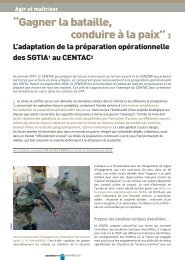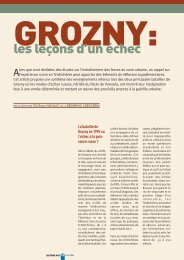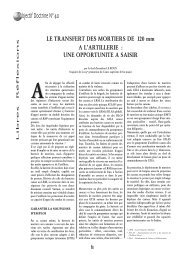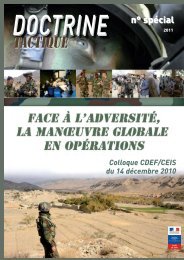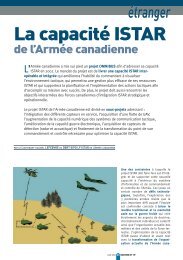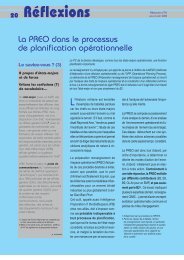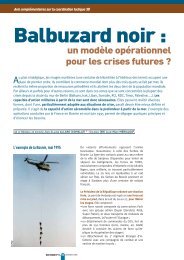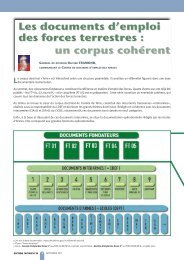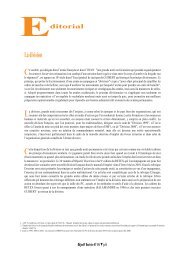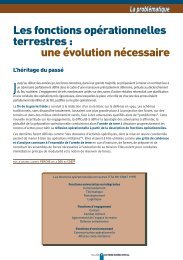Air force ground-to-air defense assets - Le Centre de Doctrine d ...
Air force ground-to-air defense assets - Le Centre de Doctrine d ...
Air force ground-to-air defense assets - Le Centre de Doctrine d ...
Create successful ePaper yourself
Turn your PDF publications into a flip-book with our unique Google optimized e-Paper software.
His<strong>to</strong>ry of the contemporary anti-<strong>air</strong>craft <strong><strong>de</strong>fense</strong><br />
within the <strong>Air</strong> Force<br />
For the <strong>Air</strong> Force, the protection of the <strong>Air</strong> Force bases, where<br />
strategic <strong>Air</strong> Force units were located, was a priority, resulting<br />
from the above-mentioned directives. As early as 1977, it was<br />
equipped with the following <strong>assets</strong>, by favoring <strong>assets</strong>'<br />
complementarity.<br />
✔ Short-range : Crotale 3000.<br />
✔ Very short-range : 20-mm twin-barreled.<br />
Procuring these weapon systems has led <strong>to</strong> the creation of two<br />
types of units reporting <strong>to</strong> the Operational Assets component of<br />
the stationing bases: the Ground-<strong>to</strong>-<strong>Air</strong> Missile Squadrons (EMSA),<br />
the <strong>Air</strong> Defense Forces Command (CAFDA) management<br />
squadrons, as well as the Ground-<strong>to</strong>-<strong>Air</strong> Defense Pla<strong>to</strong>ons (SDSA),<br />
and the regional management squadrons. When the building-up<br />
was achieved in 1985, 11 Ground-<strong>to</strong>-<strong>Air</strong> Missile Squadrons<br />
(EMSA), and 34 Ground-<strong>to</strong>-<strong>Air</strong> Defense Pla<strong>to</strong>ons (SDSA), <strong>to</strong> which<br />
<strong>Doctrine</strong><br />
Ground-<strong>to</strong>-<strong>air</strong> <strong><strong>de</strong>fense</strong> in the <strong>Air</strong> Force<br />
by lieutenant-colonel Grysewski,<br />
Head of the CASSIC <strong>ground</strong> <strong>to</strong> <strong>air</strong> <strong><strong>de</strong>fense</strong> branch<br />
(<strong>Air</strong> Command for Communication, Information and Surveillance Systems)<br />
IN THE AIR FORCE, THE GROUND-TO-AIR DEFENSE COMPONENT HAS BEEN RE-SET UP, ACCORDING TO THE MARCH 12, 1973<br />
MINISTERIAL DIRECTIVE, WHICH RECOMMENDED TO EACH SERVICE TO ENSURE ITS OWN PROTECTION, SUPPLEMENTED BY FM<br />
(= FRENCH TTA) 139 – DATED MAY 8, 1973 -, WHICH DEALT WITH GENERAL OBJECTIVES FOR PLANNING AND EMPLOYMENT<br />
IN THE AREA OF AIR DEFENSE. IT IS RIGHT TO TALK OF REBIRTH, AS PREVIOUSLY THE AIR FORCE WAS TASKED TWICE TO<br />
PROTECT ITS FACILITIES : BY AIR ARTILLERY GROUPS FROM THE END OF WWII (WORLD WAR II) ON THE ONE HAND, AND BY<br />
NIKE HERCULES AIR SQUADRONS IN THE FEDERAL REPUBLIC OF GERMANY FROM 1959 TO 1966. BESIDES, A LARGE NUMBER<br />
OF GROUND-TO-AIR DEFENSE UNITS KEEP CURRENTLY THESE SQUADRONS' TRADITIONS LIVING AND BEAR THEIR CRESTS.<br />
IT IS NECESSARY TO GO BACK TO THE YEAR 1977 TO FIND THE FIRST GROUND-TO-AIR DEFENSE UNIT STATIONED ON AN AFB<br />
(AIR FORCE BASE) AT ISTRES, WITH THE ESTABLISHMENT OF THE 01/950 "CRAU" GROUND-TO-AIR MISSILE SQUADRON ON<br />
AFB 125. REORGANIZATIONS, MISSIONS' EVOLUTION AND PROCUREMENT OF MORE EFFICIENT PIECES OF EQUIPMENT HAVE<br />
ENABLED THE AIR FORCE GROUND-TO-AIR DEFENSE TO BE RESTRUCTURED, MODERNIZED AND INTEGRATED INTO THE AIR<br />
DEFENSE. THE EVOLUTION OF STRUCTURES, THE EMPLOYMENT DOCTRINE OF GROUND-TO-AIR ASSETS BY THE AIR FORCE, A<br />
SUMMARY DESCRIPTION OF THESE ASSETS, AS WELL AS THE IMPLEMENTATION OF THE ABOVE-MENTIONED DOCTRINE DURING LIVE<br />
FIRING CAMPAIGNS ARE THE ISSUES THAT WILL SUCCESSIVELY BE TACKLED IN THIS ARTICLE.<br />
Objectif <strong>Doctrine</strong>•N° 31•p.35<br />
one Specialized <strong>Air</strong> Assets Maintenance and Rep<strong>air</strong> Group<br />
(GERMAS) was ad<strong>de</strong>d, are the <strong>Air</strong> Force <strong>ground</strong>-<strong>to</strong>-<strong>air</strong> <strong><strong>de</strong>fense</strong><br />
system. Because of short-range and very short-range weapons<br />
complementarity, it was <strong>de</strong>ci<strong>de</strong>d <strong>to</strong> merge the units located on a<br />
same <strong>Air</strong> Force base on January 1, 1987, <strong>to</strong> give birth <strong>to</strong> the<br />
Ground-<strong>to</strong>-<strong>Air</strong> Defense Squadrons (EDSA), while moving the<br />
Ground-<strong>to</strong>-<strong>Air</strong> Defense Pla<strong>to</strong>ons (SDSA) un<strong>de</strong>r <strong>Air</strong> Defense Forces<br />
Command (CAFDA) management. At that time, the situation was<br />
the following: a <strong>to</strong>tal of 36 units broken down in<strong>to</strong> 13 Ground-<strong>to</strong>-<br />
<strong>Air</strong> Defense Squadrons (EDSA), 19 Ground-To-<strong>Air</strong> Defense<br />
Pla<strong>to</strong>ons (SDSA), and 1 Specialized <strong>Air</strong> Assets Maintenance and<br />
Rep<strong>air</strong> Group (GERMAS).<br />
Thereafter, two successive restructurings led <strong>to</strong> the current size:<br />
10 Ground-<strong>to</strong>-<strong>Air</strong> Defense Squadrons (EDSA), one <strong>ground</strong>-<strong>to</strong>-<strong>air</strong><br />
<strong>de</strong>tachment in Djibouti, and one Specialized Technical Support<br />
Squadron (ESTS); these units reporting <strong>to</strong> the <strong>Air</strong> Command for<br />
Communication, Information and Surveillance Systems (CASSIC)<br />
since June 1, 1994, when this organic command was set up.<br />
Besi<strong>de</strong>s, the recent armed <strong>force</strong>s' reforms have been an<br />
opportunity <strong>to</strong> transform units in<strong>to</strong> 100 % all-volunteer ones units<br />
and <strong>to</strong> adapt their sizes <strong>to</strong> the various systems' implementation<br />
requirement, hence improving their efficiency.
The <strong>Air</strong> Force <strong>ground</strong>-<strong>to</strong>-<strong>air</strong> <strong>assets</strong> employment<br />
commitment doctrine<br />
Drafted in May 2000 by the Joint Staff in co-operation with the<br />
three Services' components, the surface-<strong>to</strong>-<strong>air</strong> <strong>assets</strong> commitment<br />
concept is as follows:<br />
"Surface-<strong>to</strong>-<strong>air</strong> <strong><strong>de</strong>fense</strong> is an essential function, whose<br />
mastering directly conditions the effectiveness of the<br />
home terri<strong>to</strong>ry's protection or the safeguard of an<br />
operating <strong>force</strong>. It requires <strong>to</strong> resort <strong>to</strong> a dynamic<br />
posture <strong>to</strong>wards the evolution of the threat, of the<br />
<strong>force</strong>'s structure, as well as of its environment, within<br />
a joint and multinational scope, by:<br />
- integrating this requirement in<strong>to</strong> the planning phase as<br />
early as possible, without concealing the building-up<br />
transitional periods;<br />
- adopting a global approach within the <strong>air</strong> <strong><strong>de</strong>fense</strong><br />
framework of <strong>air</strong> <strong><strong>de</strong>fense</strong> un<strong>de</strong>r the authority of a<br />
single command;<br />
- searching for an optimal complementarity between the<br />
systems, whose implementation's efficiency is directly<br />
<strong>de</strong>pen<strong>de</strong>nt on a real time and-outstanding information's<br />
flow."<br />
❖<br />
The <strong>Air</strong> Force <strong>ground</strong>-<strong>to</strong>-<strong>air</strong> <strong>assets</strong> employment doctrine results:<br />
� on the one hand, from the initial protection requirements of<br />
nuclear <strong>air</strong> bases, thus reinforcing <strong>de</strong>terrence credibility;<br />
� on the other hand, from the terms of the above mentioned<br />
concept.<br />
The <strong>Air</strong> Force does not consi<strong>de</strong>r <strong>ground</strong>-<strong>to</strong>-<strong>air</strong> <strong><strong>de</strong>fense</strong> <strong>assets</strong><br />
commitment, without being integrated in<strong>to</strong> a global <strong>air</strong> <strong><strong>de</strong>fense</strong><br />
system, whose principle relies on a complementarity between the<br />
manned <strong>air</strong> component and the <strong>ground</strong>-<strong>to</strong>-<strong>air</strong> weapon systems<br />
connected <strong>to</strong> a common network, which is the <strong>Air</strong> Defense<br />
<strong>Doctrine</strong><br />
Objectif <strong>Doctrine</strong>•N° 31•p.37<br />
Information Display and Transmission System (STRIDA) for home<br />
terri<strong>to</strong>ry. Space management and coordination enable <strong>to</strong> avoid<br />
blue-on-blue fires and <strong>to</strong> increase weapons' efficiency.<br />
On that account, <strong>ground</strong>-<strong>to</strong>-<strong>air</strong> <strong><strong>de</strong>fense</strong> <strong>assets</strong> - placed un<strong>de</strong>r the<br />
operational control of the <strong>air</strong> <strong><strong>de</strong>fense</strong> comman<strong>de</strong>r or of an<br />
equivalent theater <strong>air</strong> au<strong>to</strong>rity take part in carrying out <strong>air</strong><br />
security active measures, among which commitment. These<br />
<strong>assets</strong>' coherent commitment takes place within a logic of or<strong>de</strong>r<br />
centralization. However, for clearly i<strong>de</strong>ntified operational<br />
requirements – in case of liaison breakdown <strong>to</strong>wards higher<br />
authorities – provisions for <strong>de</strong>centralizing or<strong>de</strong>rs are being set up<br />
by the operational command in or<strong>de</strong>r <strong>to</strong> carry out the protection<br />
mission continuity. Finally, the current squadrons do not<br />
systematically carry out their missions on their stationing <strong>Air</strong><br />
Force base. As for every <strong>Air</strong> Force unit, Ground-<strong>to</strong>-<strong>Air</strong> Defense<br />
Squadrons (EDSA) are mobile and self-sufficient combat units,<br />
which are likely <strong>to</strong> protect any facility categorized as "<strong><strong>de</strong>fense</strong><br />
priority facility", either on the home terri<strong>to</strong>ry or on an overseas<br />
operation theater. Following the September 11, 2001 events,<br />
current <strong>de</strong>ployments within the framework of home terri<strong>to</strong>ry <strong>air</strong><br />
security rein<strong>force</strong>ment are very concrete examples of the <strong>Air</strong><br />
Force implementation of this doctrine.<br />
<strong>Air</strong> <strong>force</strong> <strong>ground</strong>-<strong>to</strong>-<strong>air</strong> <strong><strong>de</strong>fense</strong> <strong>assets</strong><br />
Initially, the complementarity of short-range and very shortrange<br />
systems was sought after, and then a coordination<br />
requirement for their implementation, as well as a <strong>de</strong>localization<br />
requirement came up, when facing the threat's evolution (new<br />
stand-off weapon systems).<br />
So, <strong>assets</strong> available <strong>to</strong> the <strong>Air</strong> Force <strong>to</strong> ensure its own <strong>ground</strong>-<strong>to</strong><strong>air</strong><br />
<strong><strong>de</strong>fense</strong> can be <strong>de</strong>scribed around three axes: short-range, very<br />
short-range, and coordination.<br />
� There are two short-range systems : the Crotale NG and the<br />
Crotale 3000 EVA.<br />
- Fitted with 8 VT1 missiles – with an 11 km range – the Crotale<br />
NG is a single-unit weapon system <strong>de</strong>veloped <strong>to</strong> meet <strong>air</strong> threats<br />
composed as well of fixed-wing <strong>air</strong>craft flying at subsonic and<br />
supersonic speeds, as of hovering helicopters.
This weapon system provi<strong>de</strong>s the surveillance, i<strong>de</strong>ntification,<br />
tracking and firing e functions on its own.<br />
- The upgra<strong>de</strong>l Crotale is an improved version of the initial<br />
Crotale 3000: a firing pla<strong>to</strong>on, composed of one acquisition<br />
unit, which carries out watch and i<strong>de</strong>ntification, connected <strong>to</strong> 1,<br />
2 or three firing units, each equipped with 4 R440 missiles (with<br />
a range of 8,5 km), and tracking and locating one target, as<br />
well as one or two missiles.<br />
� Three very short range systems: the Aspic, Tripod and twinbarreled<br />
systems.<br />
- The Aspic is an au<strong>to</strong>mated firing e unit implementing 4 Mistral<br />
missiles with a 5 km range, fitted on a two-ax servo-controlled<br />
turret and equipped with an optronic fire-control system (a<br />
day-vision camera and a night-vision camera).<br />
- The Tripod is a single-munition manpad system, which also<br />
implements the Mistral missile.<br />
- The 76T2 twin-barreled gun is a laying and fire-control<br />
system, with a manual sight and an au<strong>to</strong>matic extrapolation,<br />
fitted with 20-mm shells. Its effective range is 1500 m.<br />
❖<br />
� Coordination is carried out by a fixed of removable au<strong>to</strong>mated<br />
tactical cell, whose operational mission consists in coordinating<br />
and optimizing the commitment of <strong>de</strong>ployed <strong>ground</strong>-<strong>to</strong>-<strong>air</strong><br />
weapon systems, in coherence with the <strong>air</strong> <strong><strong>de</strong>fense</strong><br />
components. It is important <strong>to</strong> note that coordination can also<br />
be established at the level of the very weapon systems, more<br />
specifically between the Acquisition and Fire-Control Unit (UAT)<br />
and the Crotale NG, or between the Acquisition and Fire-Control<br />
Unit (UAT), the Crotale NG, and the Aspic, thus providing<br />
pspecially interesting options for tailoring, survivability, and<br />
discretion.<br />
These highly mobile systems are broken down in<strong>to</strong> the ten home<br />
squadrons and the Djibouti <strong>ground</strong>-<strong>to</strong>-<strong>air</strong> <strong>de</strong>tachment:<br />
- Very short range <strong>assets</strong> and an au<strong>to</strong>mated Tactical Cell (CETAC)<br />
are available <strong>to</strong> all squadrons;<br />
<strong>Doctrine</strong><br />
Objectif <strong>Doctrine</strong>•N° 31•p.39<br />
- Three squadrons are equipped with Crotales NG;<br />
- Seven squadrons implement the Crotale EVA;<br />
- The <strong>de</strong>tachment is fitted with very short-range <strong>assets</strong>.<br />
Within a squadron, opera<strong>to</strong>rs - <strong>de</strong>pending upon their training's<br />
progress - are able <strong>to</strong> operate all the weapon systems.<br />
❖<br />
❖ ❖<br />
Live firing campaigns carried out by the <strong>Air</strong> Force<br />
In or<strong>de</strong>r <strong>to</strong> place the crews in front of the sophisticated<br />
environment of the situations <strong>to</strong> which they are likely <strong>to</strong> be faced<br />
- the <strong>Air</strong> Force <strong>ground</strong>-<strong>to</strong>-<strong>air</strong> live firing campaigns have<br />
consi<strong>de</strong>rably evolved during these last years, shifting from firing<br />
one missile <strong>to</strong>wards one target <strong>to</strong> sophisticated scenarios,<br />
implementing several weapon systems, whose simultaneous firing<br />
actions <strong>to</strong>wards many targets are moni<strong>to</strong>red by an au<strong>to</strong>mated<br />
tactical cell. According <strong>to</strong> the proposed scenarios, targets - each of<br />
them engaged by a different weapon system - simulate a sample<br />
group of various and mo<strong>de</strong>rn threats, according their features<br />
(low SER or SIR, swift or slow speed, dropping of infrared <strong>de</strong>coys<br />
and chaffs).<br />
On these occasions, the CASSIC en<strong>de</strong>avors <strong>to</strong> make full use of all<br />
the capabilities granted by the systems that are fiel<strong>de</strong>d in its<br />
subordinate units, and thus, <strong>to</strong> re-create a context as realistic as<br />
possible in the trial centers. Its ambition is <strong>to</strong> apply the <strong>Air</strong> Force<br />
doctrine, especially the coordination and complementarity<br />
principles that cannot be ignored within of an <strong>air</strong> <strong><strong>de</strong>fense</strong> system<br />
architecture; thus, the complete chain <strong>to</strong> gather clues and <strong>to</strong><br />
analyze the threat is being implemented: receiving the local <strong>air</strong><br />
situation worked out by a tactical control module, the au<strong>to</strong>mated<br />
Tactical Cell (CETAC) coordinates the engagements of all the<br />
weapon systems that are connected <strong>to</strong> it (Crotale NG, Crotale EVA,<br />
Aspic or Tripod). Selectively, the <strong>air</strong>borne <strong>de</strong>tection and control<br />
provi<strong>de</strong>s its part, by forwarding an <strong>air</strong> situation <strong>to</strong> the MCT.
As a young branch, the <strong>Air</strong> Force <strong>ground</strong>-<strong>to</strong>-<strong>air</strong> <strong><strong>de</strong>fense</strong> has<br />
reached the age of reason; in or<strong>de</strong>r <strong>to</strong> not regress, this adult will<br />
continue <strong>to</strong> mature. Within a more or less near future, three<br />
sections will characterize its inevitable evolution: the<br />
improvement of current systems, the procurement of new<br />
systems, as well as a foreseeable units' downsizing.<br />
As far as the current weapon systems are concerned, introducing<br />
tactical data links will open new horizons, which are still<br />
unreachable currently; the integration in<strong>to</strong> the <strong>air</strong> <strong><strong>de</strong>fense</strong> chain,<br />
as well as systems' flexibility will be but strengthened. In parallel,<br />
missile systems are regularly improved <strong>to</strong> meet threats'<br />
mo<strong>de</strong>rnization.<br />
<strong>Doctrine</strong><br />
Objectif <strong>Doctrine</strong>•N° 31•p.41<br />
By the year 2010, the <strong>Air</strong> Force will be fiel<strong>de</strong>d with a middle<br />
range system, well fitted <strong>to</strong> the new threat's features. The Middle<br />
Range Ground-<strong>to</strong>-<strong>Air</strong>/Land (SAMP/T) system will be a new<br />
advantage for the applied doctrine.<br />
Last, the arrival of the Middle Range Ground-<strong>to</strong>-<strong>Air</strong>/Land<br />
(SAMP/T) system will result in<strong>to</strong> a new units' downsizing, with a<br />
global strength that will remain about the same as <strong>to</strong>day, due <strong>to</strong><br />
the large number of fiel<strong>de</strong>d weapon systems. The whole of these<br />
evolutions, the <strong>de</strong>velopped reflections, as well as the <strong>air</strong>space<br />
management and coordination strengthen the everlasting position<br />
of a <strong>ground</strong>-<strong>to</strong>-<strong>air</strong> <strong><strong>de</strong>fense</strong> closely linked <strong>to</strong> the <strong>Air</strong> Force<br />
employment within a coherent chain involving all the ac<strong>to</strong>rs ■<br />
LA COORDINATION DES MOYENS SOL-AIR DANS LA DEFENSE AERIENNE<br />
COORDINATION OF GROUND-TO-AIR ASSETS IN AIR DEFENSE





